There’s been a LOT of discussion lately in historical costuming circles about the origins and eighteenth-century meanings of the chemise à la reine, a style of gown popular in the 1780s and 1790s. Having read a number of the academic sources on the style, I thought I could contribute to the discussion by outlining the scholarship on the subject.
First, let’s define the chemise à la reine. It actually went by a number of different names, including gaulle, robe en chemise, and then many variations like the chemise à la Floricourt or chemise à la Jesus. “Robe en chemise” is the phrase used most frequently in French fashion magazines of the period (Gallerie des Modes, Cabinet des Modes, Magasin des Modes, and Journal de la Mode et du Goût), and so the term I tend to use. The term “chemise à la reine” began to be used after the dress became associated with French Queen Marie-Antoinette when the famous portrait of her wearing the gown by Elisabeth Vigée-LeBrun was exhibited at the 1783 Paris Salon; this engendered widespread criticism based on the gown’s perceived informality.
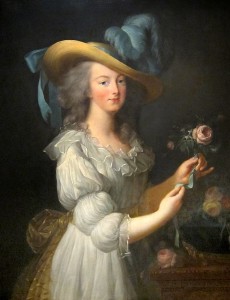
The best description of the robe en chemise comes from Kimberly Chrisman-Campbell’s book Fashion Victims: Dress at the Court of Louis XVI and Marie-Antoinette (2015), which I’ll talk about a bit more below:
“The gown that would become known as the chemise à la reine was similar to the female undergarment [chemise in French, shift or smock in English] in construction, with a gathered neckline and a dropped shoulder seam, but it was not identical… Unlike the comparatively close-fitting undergarment of the same name (which doubled as a nightgown), the chemise gown had ample volume. The gown was long, though not long enough to impede walking… The gown often had a deep flounce at the hem… The gown could be made of a variety of fabrics; [cotton] muslin was the most popular, but crêpe, silk gauze, lawn, and linen were also used… The gown could be colored… [and] was usually fitted by drawstrings rather than being tailored…”
My summary is:
- A gown made from rectangular shapes [EDITED TO ADD: Fanny of Temps d’Elegance tells me she’s studied the later Oberkampf dress (see pics below), and that dress’s shapes are more triangular than rectangular. She’ll have some blog posts about this in the coming months], either entirely open down the front or closed
- These rectangular body shapes were extremely full, and controlled via gathers at the neckline and waist; there could also be another gathering row at the underbust
- Early examples were full and gathered all around; later examples have fitted backs
- Early examples have full sleeves, gathered at the elbow and sometimes higher up the arm; later examples have fitted sleeves
- There was often one or more flounces at the neckline and/or hem
- It was often (but not always!) made of sheer fabrics, and often made in white
- It was usually worn with a wide sash
There are two main, interconnecting theories on the origins of the robe en chemise, neither of which are hard and fast — because in academic scholarship, one never says something 100% IS unless one has clear documentation (historical sources) for saying that. And even if one source suggests something, you need MORE sources to corroborate them.
Jane Ashelford’s article “‘Colonial livery’ and the chemise à la reine, 1779–1784,” published in the journal Costume in 2018, explores the gown’s Caribbean connections. Ashelford writes about how the cottons produced in the French colony of Saint-Domingue (modern-day Haiti) were much whiter and finer than those washed in Europe (which tended to have a yellow-ish tint). [Cotton had been increasingly popular since the seventeenth century, but really began to take off in France when prohibitions against its importation were removed in 1759]. Ashelford goes on to write that French fashions were translated for the tropics:
“The clothes worn by the free women of colour [who were generally of mixed French and African ancestry] were an assimilation and refashioning, not so much of metropolitan fashion but of the regional dress worn by the petits blancs [skilled or unskilled workers and tradesmen]. Mainly immigrants from Bordeaux and Aquitaine who had left France hoping for a more prosperous life, they were the wives of men of moderate means who had smallholdings in the less fertile parts of the island or worked on the large plantations as bookkeepers, overseers and engineers and in the towns as tradespeople and artisans… The dress of a woman of the artisan class in Bordeaux was very distinctive… [and consisted of a] jacket with its distinctive lacing, the shorter-length skirt and… red kerchief…”
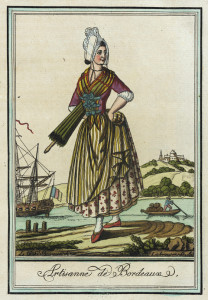
According to Ashelford, it was upper class white women in Saint-Domingue who began wearing the robe en chemise as an adaptation of French dress to the tropical climate:
“The grands blancs [white ‘plantation owners and rich merchants’] of Saint-Domingue expressed their French identity through the latest metropolitan fashions… It would have been considered ‘improper, ridiculous and detrimental’ to wear fashions suitable to the ‘cold Northern air’ in a perpetually hot climate… The gaulle, also known as a ‘robe d’intérieur de coton blanc’ [house gown of white cotton], was the perfect solution for ladies…”
It’s unclear from Ashelford’s research exactly what inspired the robe en chemise, and that’s probably because there are no direct sources for this (just as there generally aren’t for most styles of dress). She does quote another researcher, Madeleine Dobie (Trading Places: Colonization and Slavery in Eighteenth-Century French Culture), about “crossovers [in dress] from whites to free people of colour and vice versa,” pointing specifically to “the desire of the white elite to copy the headwrap.” There’s a really interesting article at SX Salon that looks more at West African origins for these headwraps. As Ashelford notes, there are a lot of visual connections between the dress worn by free women of color and white women in the Caribbean with the chemise gown:
Ashelford then talks about how the dress was first seen in France in Bordeaux, worn by women who were traveling back and forth between that city and Saint-Domingue.
However, the fact that Ashelford calls the gown a “robe d’intérieur” — essentially what we would consider a robe, meaning an overgarment worn inside the home that’s slightly more dressed than sleepwear but not suitable for wearing outside of the home — is key, and connects to the other main researcher to look at the origins of this style, Kimberly Chrisman-Campbell.
Chrisman-Campbell looks at the robe en chemise in both her dissertation and her book Fashion Victims. She talks about how the gown’s “simplicity and informality evoked the pastoral ideal so prevalent in eighteenth-century art and literature” (in other words, the fashion for dress à la paysanne, or in the peasant style). She writes that the robe en chemise “was inspired by the dress and textiles of the French colony of Saint-Domingue.” She connects the cut of the style to the peignoir or house gown, “the loose garment ladies wore to protect their clothes while having their hair dressed and powdered,” examining this early example of the gown worn by Madame du Barry:
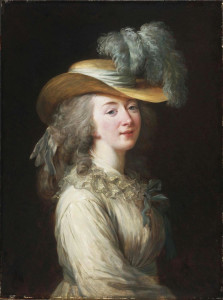
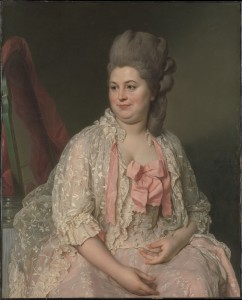
So why did Marie-Antoinette receive so much criticism for wearing the robe en chemise in the 1783 portrait? Chrisman-Campbell summarizes it well: “By simplifying her style of dress, Marie-Antoinette unwittingly neglected her twin responsibilities: to encourage French manufactures and the dignity the throne.” The fact that the chemise gown was often made in cotton was thought to be contributing to the ongoing decline of the French silk industry, something the queen had come under fire for repeatedly in earlier years; and by dressing informally, she was thought to be undercutting the dignity of the French monarchy. There’s also issues with the fact that the gown was associated with the queen’s private retreat of the Petit Trianon, which was the locus for her supposedly scandalous lifestyle (she was accused of promiscuity and of spying for her native country of Austria).
So, can we say that the chemise à la reine was an appropriation by white European women of the clothing of enslaved women in the Caribbean? I think that’s a stretch. It’s possible, but the scholarship isn’t there. According to an article by Chaela Pastore, “Slave corps in Saint-Domingue, comprised loosely of domestic slaves, field slaves and worker slaves, used dress to mark differences in their status.” Some were described in historical sources as being dressed in rags, others “in their Sunday clothes… The Women wore rather thin dresses and short aprons; their kinky hair was covered by a Madras headkerchief, beautifully tied; nearly all had on necklaces and earrings” (this quote is from 1793). Furthermore, Pastore argues, “sumptuary laws for slaves began around 1720, specifying acceptable clothing for freed slaves, valets and servants, and field slaves. The emergence of these laws, along with the comments made by travelers in the colony, suggests that slaves made efforts to embellish their appearance, and that colonists found such efforts threatening.” (An interesting article that focuses on the English colony in Jamaica argues that by “‘marking’ English-produced textiles with their own expressions and transforming English textiles into clothes suiting their own taste [enslaved people] may have challenged the aesthetic and social authority of slaveholders” — in other words, through dress, enslaved people found agency and resistance.)
Was the robe en chemise derived from clothing worn by free women of color and white women in the Caribbean? It seems very likely — there was a continuum of dress between free women of color and white women, and the style was definitely worn by upper class white women. Did those women live in a slave society? Definitely. Did the style also derive in part from the dressing gown? A strong possibility. There are also some potential Ottoman connections too.
So what about Racked.com’s article connecting the popularity of the chemise à la reine to the market for cotton and the resulting growth of the slave trade? Sure, the chemise gown contributed to this… as did the fashion for most styles of the late eighteenth century, including the robes à la polonaise, anglaise, lévite, and more, as well as the popularity of cotton for interior furnishings and domestic uses. Writing about printed cottons imported from India, Beverly Lemire and Giorgio Riello state,
“Whether in cushions, kerchiefs, bed quilts or curtains, by the seventeenth century tastes for this product [cotton fabrics] were well established, growing larger with the sustained marketing by trading companies…”
The larger taste for informality in French fashion, which dates from the 1760s, was responsible for the popularity of cotton in dress, not just one particular style. This trend was inspired by the writings of Enlightenment philosophers, and was connected to Middle Eastern, English, and peasant-inspired fashions — as well as those from the Caribbean. According to Aileen Ribeiro (A Visual History of Costume: The Eighteenth Century),
“The last quarter of the eighteenth century was a period of both fantasy and informality in dress… Newly fashionable fabrics such as printed cotton and fine muslin were widely worn… The equation was often made between the informality of dress and democracy…”
In fact, Marie-Antoinette personally received criticism about not promoting the French silk industry in relation to all of the various informal, fashionable styles she wore in this period. Here I’ll quote my own research (“Contextualizing Wertmüller’s 1785 Portrait of Marie-Antoinette through Dress“):
“Marie-Antoinette… came under repeated fire for not adequately promoting the French silk industry based in Lyon. In 1779 and 1780, silk manufacturers complained to the King that the popularity of ‘les polonoises, les circassiennes, les turques, les lévites’ caused the massive demand for cotton fabrics and resulting decline for silk; on both occasions, the Queen announced she would forgo these styles and disallow them from court. However, these decisions clearly did not last long, given these incidents’ repetition, and the Queen’s wardrobe inventories continued to include these gowns… Accusations… continued until after the Revolution, that she was personally destroying the silk industry. According the Abbé Soulavie’s memoirs, ‘The Queen took advantage of all these circumstances to change and simplify our costumes, and she did so to the detriment of our national industry [. . .]. Thousands of families, busy with our arts, fell into inaction and misery, and discontent broke out.'”
If you’re interested in reading more about the chemise gown, I highly recommend both Ashelford and Chrisman-Campbell. Other useful sources are Mary Sheriff’s “The Portrait of the Queen” (in Marie Antoinette: Writings on the Body of a Queen), Caroline Weber’s Queen of Fashion: What Marie Antoinette Wore to the Revolution, and Sarah Lorraine Goodman’s Devil in a White Dress: Marie-Antoinette and the Fashioning of a Scandal.
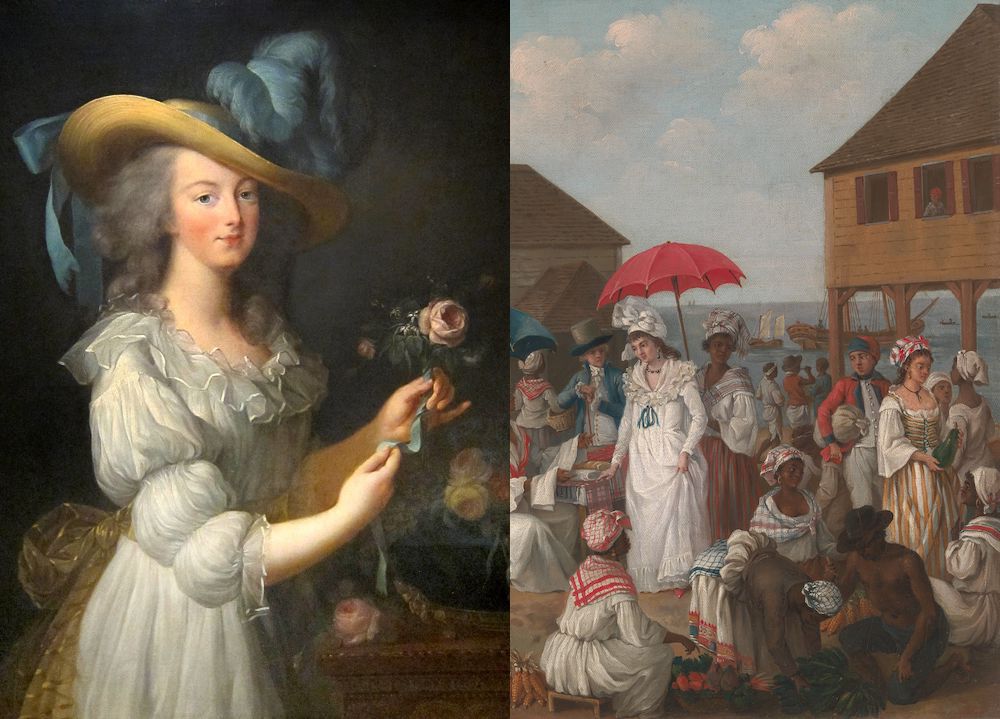
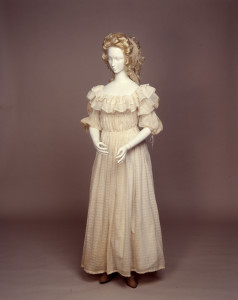
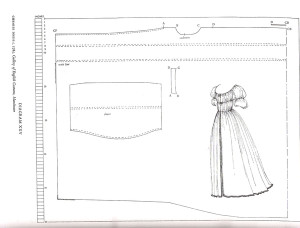
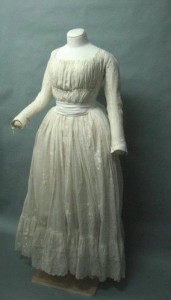
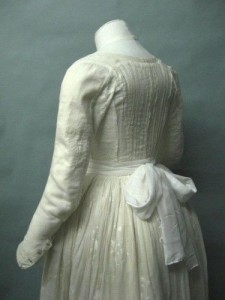
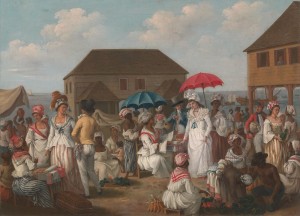
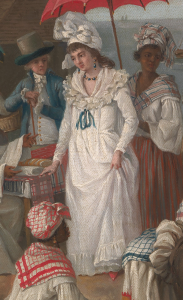
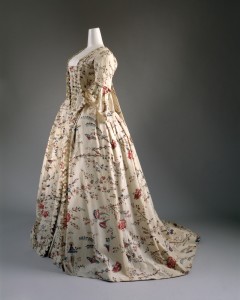
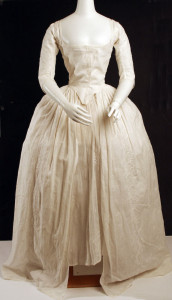
One thought on “On the Origins of the Chemise à la Reine”